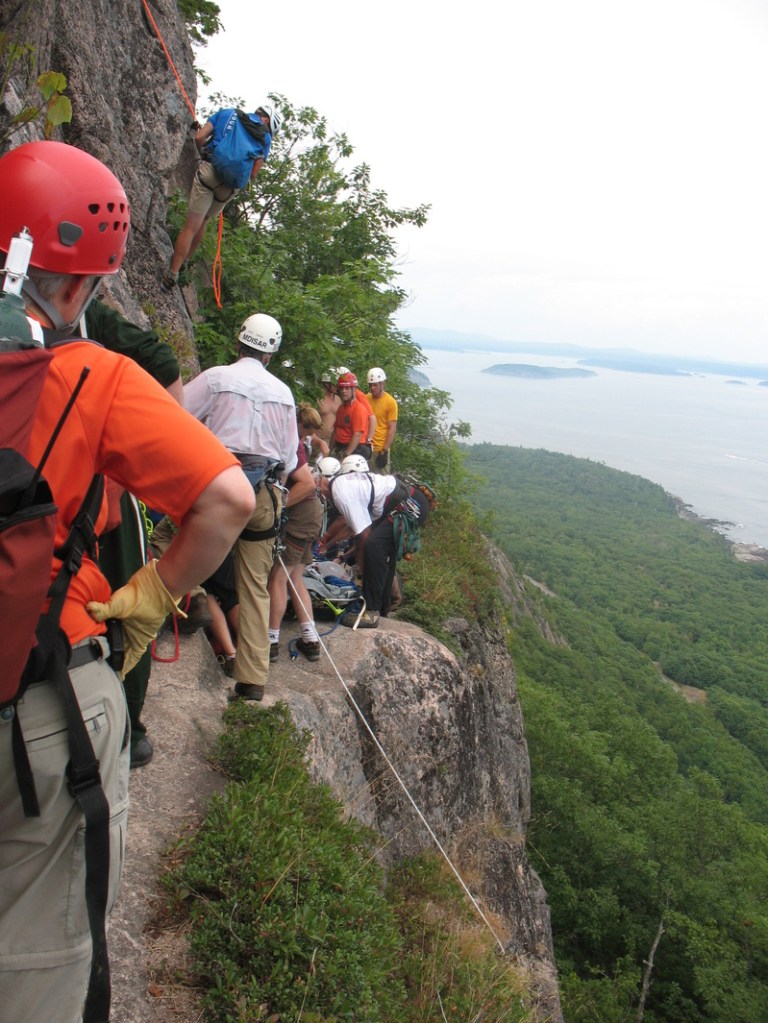The trail that Shirley Ladd was hiking Saturday when she fell 60 feet to her death is one of the most popular — and most dangerous — in Acadia National Park.
Still, it had been 27 years since someone died while hiking the Precipice Trail, a jagged wall of rock that rises from the eastern base of Champlain Mountain. In fact, fatalities at Acadia National Park and at national parks in general are rare, according to statistics kept by the National Park Service.
Ladd, 22, a University of Maine student from Barnstead, N.H., slipped and fell while climbing with a friend Saturday. She had just finished scaling a laddered section of the Precipice Trail and was preparing to ascend another set of rungs when she fell from a rock shelf onto the trail below.
Dozens of rescue workers tried to save her life. She was taken by helicopter to a hospital in Bangor, where she died later that day.
Though Precipice is considered Acadia’s most treacherous trail, Ladd’s death was the first on the trail since the summer of 1985, when a male hiker fell several feet from a rocky ledge.
Acadia attracts nearly 3 million visitors every year and reports an average of one or two accidental deaths.
The National Park Service tracks unintentional fatalities at all U.S. parks, but spokesman Jeff Olson said the numbers do not always reflect cases in which someone suffers an injury at a park and dies days or weeks later. The numbers also exclude suicides and homicides. Falls are the third most common cause of death, behind drownings and motor vehicle accidents.
Ladd’s death was the third this year at Acadia. A Connecticut man committed suicide atop Cadillac Mountain in June, and someone drowned in the park about two months ago, said park ranger supervisor Richard Rechholtz.
Last year, there were a total of 155 unintentional fatalities at parks nationwide, one at Acadia, the park service reported. Deaths occurred at 52 of the nearly 400 national parks. The most occurred at Yosemite in California, which had 20.
Of the 693 unintentional fatalities at national parks from 2007 through 2011, only two were reported at Acadia, according to the park service.
In 2007, a woman from Michigan drowned while swimming off Schoodic Point. In 2011, a cross-country skier collapsed and died on one of the park’s carriage roads.
“That’s a very low number for such a busy park,” Olson said.
Rechholtz said he counted 10 deaths in Acadia dating back to 2005, although most were related to heart attacks so they didn’t show up in the national data.
The only other death not noted by the park service was that of a 7-year-old girl from New York, who drowned in 2009 after a wave swept her out to sea at Otter Cliffs. Olson said he couldn’t explain why that case was not in the park service’s numbers.
Dozens of serious injuries occur every year at Acadia, many of them on the Precipice Trail, Rechholtz said. There likely would be more casualties if the trail were open more regularly, he said. It often is closed because it’s a common nesting spot for peregrine falcons, an endangered species.
When the trail is open, it’s busy.
“A lot of people come to Acadia because they have heard about Precipice and want to hike it,” Rechholtz said.
The trail, a 1.6-mile round trip, is relatively short. Experienced hikers can reach the 1,000-foot summit in less than two hours. The challenge comes from its vertical rise and its openness. The rock face is exposed in many areas, and most of the trail has rungs and ladders to assist hikers.
Jon Tierney, who owns Acadia Mountain Guides, which offers guided tours for hikers and mountain climbers, said the Precipice is popular for the same reason that it’s dangerous.
“Certainly, it’s dramatic,” he said. “It’s a trail designed for thrill seekers and is definitely a place where people can get hurt.”
The trails at Acadia are maintained by the park’s rangers and staff, and by volunteers affiliated with the nonprofit group Friends of Acadia. Signs on the Precipice Trail say it is a “non-technical climbing route, not a hiking trail.”
The signs warn that “persons have received serious injuries and others have died on this mountainside.”
Safety information at Acadia is easily available, Tierney said, but park officials can’t force visitors to heed warnings.
“It’s always unfortunate when something like this happens, but it’s also unfortunate when an accident turns into an excuse for people to say, ‘Oh, don’t do that,'” he said. “There are risks in everything we do.”
Send questions/comments to the editors.





Comments are no longer available on this story